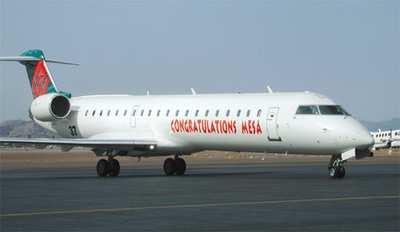High Times on the Mesa
The Airline Pilots Association International (ALPA) has announced that Mesa Airlines, the Phoenix-based Part 121 carrier doing business as American Eagle and United Express, is making ready to raise its pilots’ salaries.

Henceforth, the airline will pay its first officers and captains starting rates of $100 and $150-per-hour respectively. Mesa is the first regional airline to compensate its first officers so generously—surpassing a $90-per-hour mark set by American Airlines in June 2022.
The pay increase follows Mesa’s third-quarter earnings call, during which longtime Mesa CEO Jonathan Ornstein made clear to investors that the airline was losing pilots to American’s regional operations. The compulsion to jump ship is endemic among Mesa pilots, who—prior to the new agreement—were widely recognized as some of the lowest-paid in the regional air-carrier industry. All told, the revised Mesa compensation package represents a hefty 118% pay hike for first-year first-officers, and an even heftier 172% increase for captains.

In a statement referring to the letter of agreement between ALPA and the masters he serves, Mesa Airlines union chair Captain Chris Gill put forth: “With strong competition in the regional industry, today’s LOA offers the compensation Mesa needs to remain competitive and attract and retain experienced, qualified pilots. We’re happy to see management and our partners recognize the value of Mesa pilots.”
The two-year deal between Mesa and its pilots takes effect on 15 September 2022. In the interim, ALPA and the airline continue to negotiate the contract’s ancillary provisions.
Mesa’s paroxysm of largess coincides with a pilot shortage over which ALPA and airline industry analysts vehemently disagree. The union—which benefits from pilot-shortages real or imagined—asserts pilots are plentiful and shall remain so. Aviation pundits and flight-schools, however, insist an acute and irremediable pilot shortage looms—inevitable and catastrophic—over the whole of the commercial aviation sector. Perpetually attuned to pronouncements of extant or imminent tragedy, airline executives have hastened to offer pilots kingly salaries while prevailing upon regulators to lower airman experience minima, and raise mandatory retirement ages.

Growing certainty among economists that demand for air travel will wane dramatically against the prevailing backdrop of inflation, recession, rising food and energy costs, international upheaval, and incessant warnings of future pandemics has failed, thus far, to temper the frenzy of reactionary hiring, exorbitant remuneration, and diminished standards into which air-carriers have descended.
Notwithstanding ALPA’s assurances of a stable pilot-supply and the dearth of empirical data to the contrary, Mesa boss Ornstein, in May 2022, declared before a Senate Commerce aviation subcommittee: "The pilot shortage is the single greatest threat to the industry I have witnessed since 9/11.”
Whether or not Mr. Ornstein’s gloomy augury proves true remains to be seen. What can be stated with certainty, however, is that Mesa’s pilots—after the fashion of politicians and corporations worldwide—have profited handsomely from fear and naysaying in the 21st Century.
 NTSB Prelim: Lee Aviation LLC JA30 SuperStol
NTSB Prelim: Lee Aviation LLC JA30 SuperStol Classic Aero-TV: Curtiss Jenny Build Wows AirVenture Crowds
Classic Aero-TV: Curtiss Jenny Build Wows AirVenture Crowds ANN's Daily Aero-Term (05.30.25): Very High Frequency (VHF)
ANN's Daily Aero-Term (05.30.25): Very High Frequency (VHF) Aero-News: Quote of the Day (05.30.25)
Aero-News: Quote of the Day (05.30.25) Classic Aero-TV: Quest Kodiak Enhances Migration Monitoring Programs
Classic Aero-TV: Quest Kodiak Enhances Migration Monitoring Programs





